2014 KIA Sedona spare wheel
[x] Cancel search: spare wheelPage 351 of 382
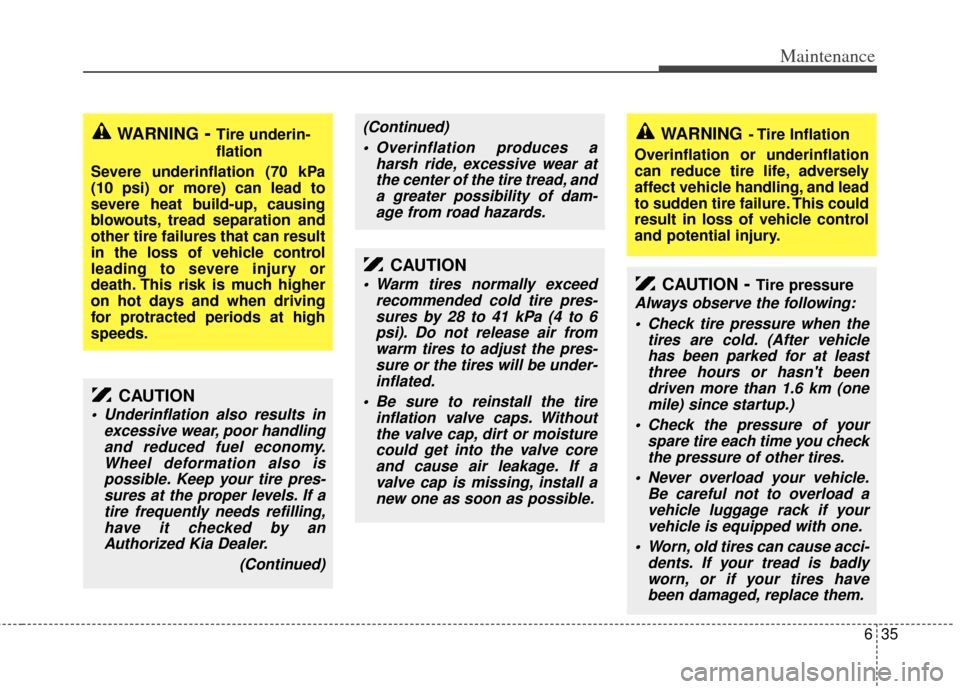
635
Maintenance
WARNING- Tire underin-
flation
Severe underinflation (70 kPa
(10 psi) or more) can lead to
severe heat build-up, causing
blowouts, t read separation and
other tire failures that can result
in the loss of vehicle control
leading to severe injury or
death. This risk is much higher
on hot days and when driving
for protracted periods at high
speeds.
CAUTION
Underinflation also results in excessive wear, poor handlingand reduced fuel economy.Wheel deformation also ispossible. Keep your tire pres-sures at the proper levels. If atire frequently needs refilling,have it checked by anAuthorized Kia Dealer.
(Continued)
WARNING- Tire Inflation
Overinflation or underinflation
can reduce tire life, adversely
affect vehicle handling, and lead
to sudden tire failure. This could
result in loss of vehicle control
and potential injury.
CAUTION- Tire pressure
Always observe the following: Check tire pressure when the tires are cold. (After vehiclehas been parked for at leastthree hours or hasn't beendriven more than 1.6 km (onemile) since startup.)
Check the pressure of your spare tire each time you checkthe pressure of other tires.
Never overload your vehicle. Be careful not to overload avehicle luggage rack if yourvehicle is equipped with one.
Worn, old tires can cause acci- dents. If your tread is badlyworn, or if your tires havebeen damaged, replace them.
CAUTION
Warm tires normally exceed recommended cold tire pres-sures by 28 to 41 kPa (4 to 6psi). Do not release air fromwarm tires to adjust the pres-sure or the tires will be under-inflated.
Be sure to reinstall the tire inflation valve caps. Withoutthe valve cap, dirt or moisturecould get into the valve coreand cause air leakage. If avalve cap is missing, install anew one as soon as possible.
(Continued)
Overinflation produces a harsh ride, excessive wear atthe center of the tire tread, anda greater possibility of dam-age from road hazards.
Page 352 of 382
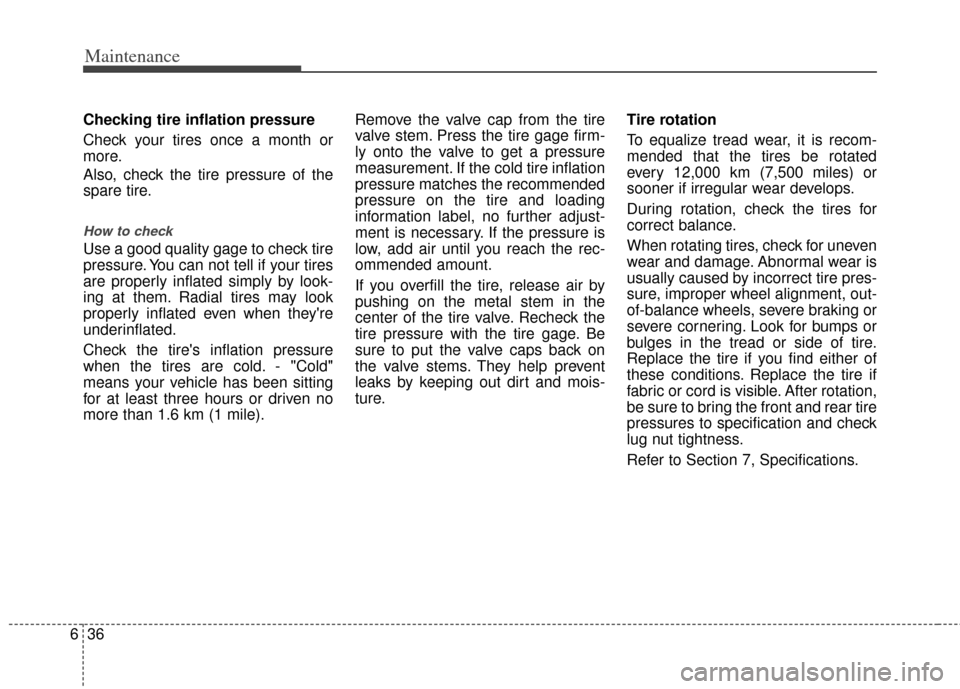
Maintenance
36
6
Checking tire inflation pressure
Check your tires once a month or
more.
Also, check the tire pressure of the
spare tire.
How to check
Use a good quality gage to check tire
pressure. You can not tell if your tires
are properly inflated simply by look-
ing at them. Radial tires may look
properly inflated even when they're
underinflated.
Check the tire's inflation pressure
when the tires are cold. - "Cold"
means your vehicle has been sitting
for at least three hours or driven no
more than 1.6 km (1 mile). Remove the valve cap from the tire
valve stem. Press the tire gage firm-
ly onto the valve to get a pressure
measurement. If the cold tire inflation
pressure matches the recommended
pressure on the tire and loading
information label, no further adjust-
ment is necessary. If the pressure is
low, add air until you reach the rec-
ommended amount.
If you overfill the tire, release air by
pushing on the metal stem in the
center of the tire valve. Recheck the
tire pressure with the tire gage. Be
sure to put the valve caps back on
the valve stems. They help prevent
leaks by keeping out dirt and mois-
ture.
Tire rotation
To equalize tread wear, it is recom-
mended that the tires be rotated
every 12,000 km (7,500 miles) or
sooner if irregular wear develops.
During rotation, check the tires for
correct balance.
When rotating tires, check for uneven
wear and damage. Abnormal wear is
usually caused by incorrect tire pres-
sure, improper wheel alignment, out-
of-balance wheels, severe braking or
severe cornering. Look for bumps or
bulges in the tread or side of tire.
Replace the tire if you find either of
these conditions. Replace the tire if
fabric or cord is visible. After rotation,
be sure to bring the front and rear tire
pressures to specification and check
lug nut tightness.
Refer to Section 7, Specifications.
Page 354 of 382
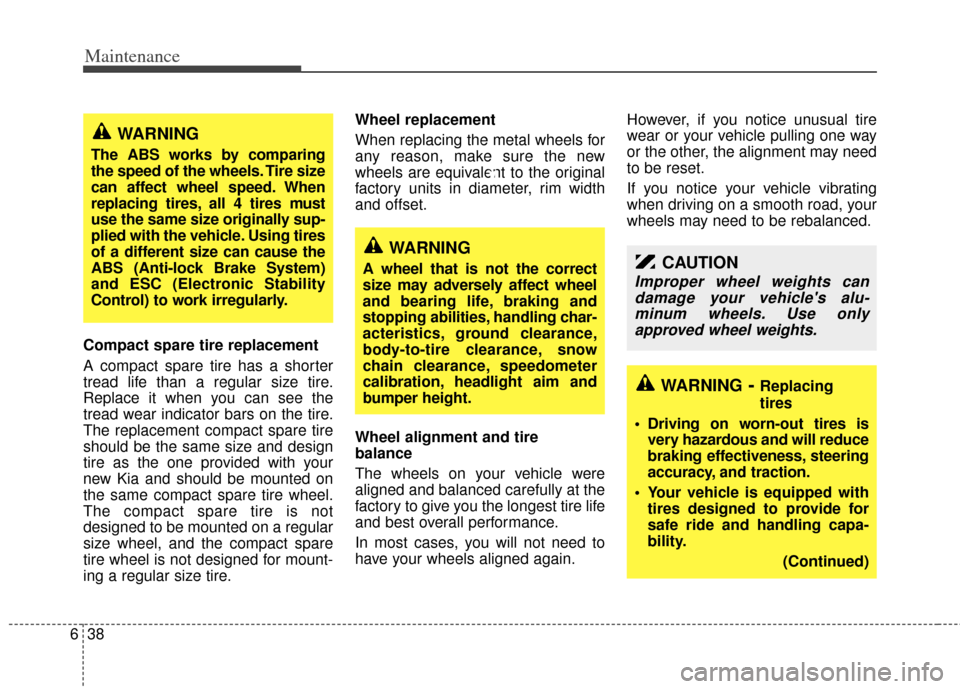
Maintenance
38
6
Compact spare tire replacement
A compact spare tire has a shorter
tread life than a regular size tire.
Replace it when you can see the
tread wear indicator bars on the tire.
The replacement compact spare tire
should be the same size and design
tire as the one provided with your
new Kia and should be mounted on
the same compact spare tire wheel.
The compact spare tire is not
designed to be mounted on a regular
size wheel, and the compact spare
tire wheel is not designed for mount-
ing a regular size tire. Wheel replacement
When replacing the metal wheels for
any reason, make sure the new
wheels are equivalent to the original
factory units in diameter, rim width
and offset.
Wheel alignment and tire
balance
The wheels on your vehicle were
aligned and balanced carefully at the
factory to give you the longest tire life
and best overall performance.
In most cases, you will not need to
have your wheels aligned again.
However, if you notice unusual tire
wear or your vehicle pulling one way
or the other, the alignment may need
to be reset.
If you notice your vehicle vibrating
when driving on a smooth road, your
wheels may need to be rebalanced.
WARNING
The ABS works by comparing
the speed of the wheels. Tire size
can affect wheel speed. When
replacing tires, all 4 tires must
use the same size originally sup-
plied with the vehicle. Using tires
of a different size can cause the
ABS (Anti-lock Brake System)
and ESC (Electronic Stability
Control) to work irregularly.
WARNING
A wheel that is not the correct
size may adversely affect wheel
and bearing life, braking and
stopping abilities, handling char-
acteristics, ground clearance,
body-to-tire clearance, snow
chain clearance, speedometer
calibration, headlight aim and
bumper height.
WARNING- Replacing
tires
Driving on worn-out tires is very hazardous and will reduce
braking effectiveness, steering
accuracy, and traction.
Your vehicle is equipped with tires designed to provide for
safe ride and handling capa-
bility.
(Continued)
CAUTION
Improper wheel weights candamage your vehicle's alu-minum wheels. Use onlyapproved wheel weights.
Page 357 of 382

641
Maintenance
3. Checking tire life (TIN : TireIdentification Number)
Any tires that are over 6 years, based
on the manufacturing date, tire
strength and performance, decline
with age naturally (even unused
spare tires). Therefore, the tires
(including the spare tire) should be
replaced by new ones. You can find
the manufacturing date on the tire
sidewall (possibly on the inside of the
wheel), displaying the DOT Code.
The DOT Code is a series of num-
bers on a tire consisting of numbers
and English letters. The manufactur-
ing date is designated by the last four
digits (characters) of the DOT code.
DOT : XXXX XXXX OOOO
The front part of the DOT means a
plant code number, tire size and
tread pattern and the last four num-
bers indicate week and year manu-
factured.
For example:
DOT XXXX XXXX 1613 represents
that the tire was produced in the 16th
week of 2013.
4. Tire ply composition and material
The number of layers or plies of rub-
ber-coated fabric in the tire. Tire
manufacturers also must indicate the
materials in the tire, which include
steel, nylon, polyester, and others.
The letter "R" means radial ply con-
struction; the letter "D" means diago-
nal or bias ply construction; and the
letter "B" means belted-bias ply con-
struction.
5. Maximum permissible inflationpressure
This number is the greatest amount
of air pressure that should be put in
the tire. Do not exceed the maximum
permissible inflation pressure. Refer
to the Tire and Loading Information
label for recommended inflation
pressure.
6. Maximum load rating
This number indicates the maximum
load in kilograms and pounds that
can be carried by the tire. When
replacing the tires on the vehicle,
always use a tire that has the same
load rating as the factory installed
tire.
7. Uniform tire quality grading
Quality grades can be found where
applicable on the tire sidewall
between tread shoulder and maxi-
mum section width.
For example:
TREADWEAR 200
TRACTION AA
TEMPERATURE A
WARNING - Tire age
Tires degrade over time, even
when they are not being used.
Regardless of the remaining
tread, it is recommended that
tires generally be replaced after
six (6) years of normal service.
Heat caused by hot climates or
frequent high loading conditions
can accelerate the aging
process. Failure to follow this
warning can result in sudden tire
failure, which could lead to a
loss of control and an accident
involving serious injury or death.
Page 373 of 382
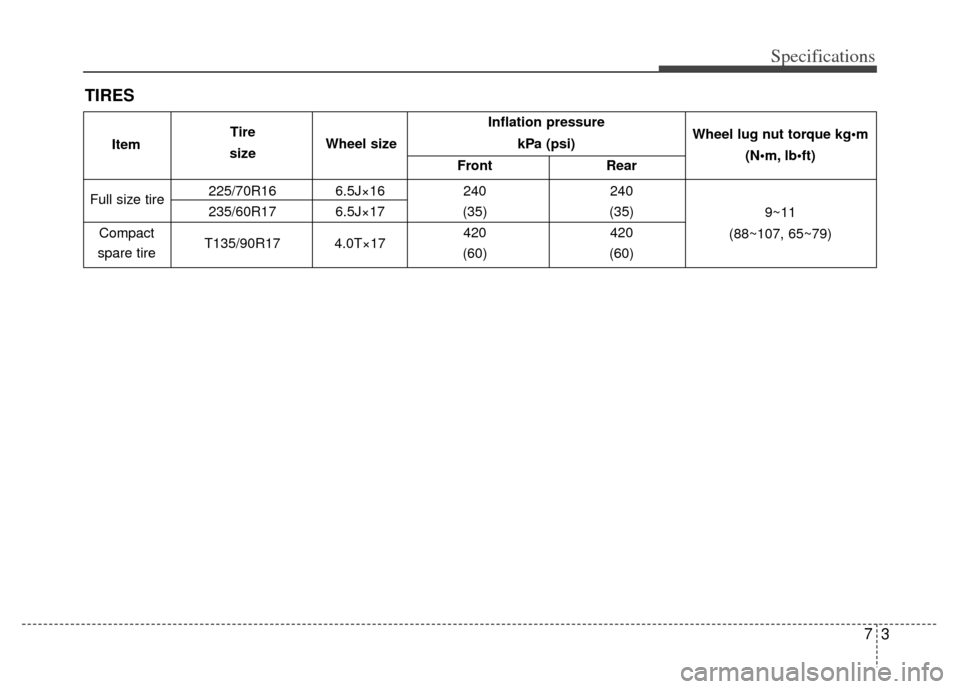
73
Specifications
Inflation pressure kPa (psi)
Front Rear
225/70R16 6.5J×16 240240
235/60R17 6.5J×17 (35)(35)
T135/90R17 4.0T×17 420
420
(60) (60)
Full size tire
Compact
spare tire Wheel lug nut torque kg•m
(N lb
9~11
(88~107, 65~79)
TIRES
Item Tire
size Wheel size
Page 381 of 382
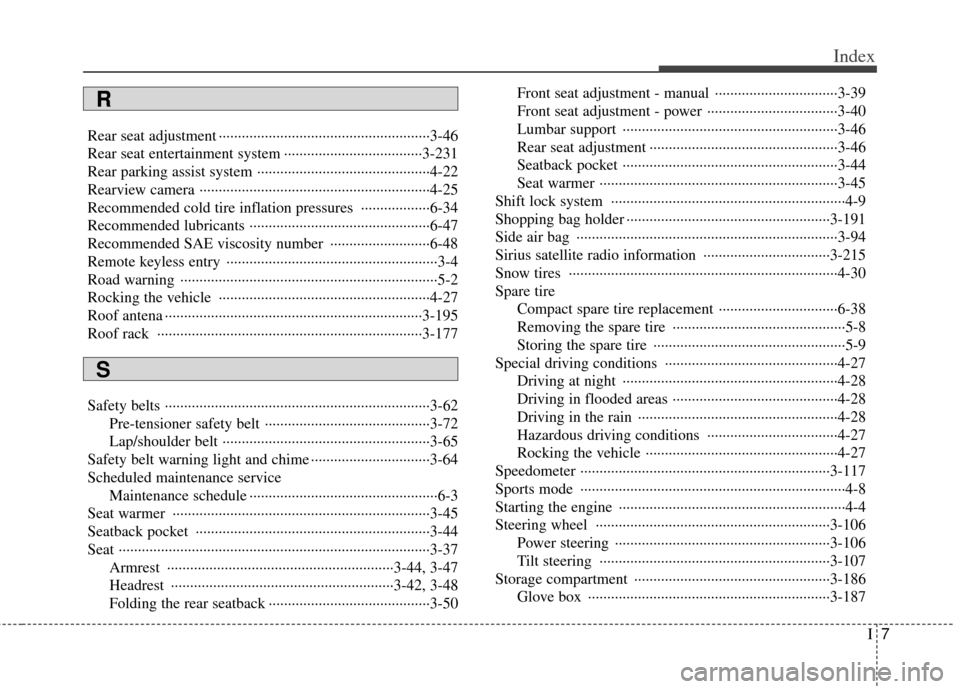
I7
Index
Rear seat adjustment ··················\
··················\
··················\
·3-46
Rear seat entertainment system ··················\
··················\
3-231
Rear parking assist system ··················\
··················\
·········4-22
Rearview camera ··················\
··················\
··················\
······4-25
Recommended cold tire inflation pressures ··················\
6-34
Recommended lubricants ··················\
··················\
···········6-47
Recommended SAE viscosity number ··················\
········6-48
Remote keyless entry ··················\
··················\
··················\
·3-4
Road warning ··················\
··················\
··················\
·············5-2
Rocking the vehicle ··················\
··················\
··················\
·4-27
Roof antena ··················\
··················\
··················\
·············3-195
Roof rack ··················\
··················\
··················\
···············3-177
Safety belts ··················\
··················\
··················\
···············3-62Pre-tensioner safety belt ··················\
··················\
·······3-72
Lap/shoulder belt ··················\
··················\
··················\
3-65
Safety belt warning light and chime ··················\
·············3-64
Scheduled maintenance service Maintenance schedule ··················\
··················\
·············6-3
Seat warmer ··················\
··················\
··················\
·············3-45
Seatback pocket ··················\
··················\
··················\
·······3-44
Seat ·················\
··················\
··················\
··················\
··········3-37 Armrest ················\
··················\
··················\
·······3-44, 3-47
Headrest ················\
··················\
··················\
······3-42, 3-48
Folding the rear seatback ··················\
··················\
······3-50 Front seat adjustment - manual ··················\
··············3-39
Front seat adjustment - power ··················\
················3-40
Lumbar support ··················\
··················\
··················\
··3-46
Rear seat adjustment ··················\
··················\
·············3-46
Seatback pocket ··················\
··················\
··················\
··3-44
Seat warmer ··················\
··················\
··················\
········3-45
Shift lock system ··················\
··················\
··················\
·······4-9
Shopping bag holder ··················\
··················\
·················3-19\
1
Side air bag ··················\
··················\
··················\
··············3-94
Sirius satellite radio information ··················\
···············3-215
Snow tires ··················\
··················\
··················\
················4-30
Spare tire Compact spare tire replacement ··················\
·············6-38
Removing the spare tire ··················\
··················\
·········5-8
Storing the spare tire ··················\
··················\
··············5-9
Special driving conditions ··················\
··················\
·········4-27 Driving at night ··················\
··················\
··················\
··4-28
Driving in flooded areas ··················\
··················\
·······4-28
Driving in the rain ··················\
··················\
················4-28
Hazardous driving conditions ··················\
················4-27
Rocking the vehicle ··················\
··················\
··············4-27
Speedometer ···············\
··················\
··················\
··············3-117
Sports mode ··················\
··················\
··················\
···············4-8
Starting the engine ··················\
··················\
··················\
·····4-4
Steering wheel ··················\
··················\
··················\
·······3-106 Power steering ··················\
··················\
··················\
··3-106
Tilt steering ··················\
··················\
··················\
······3-107
Storage compartment ··················\
··················\
···············3-186 Glove box ··················\
··················\
··················\
·········3-187
R
S
Page 382 of 382

Index
8I
Side table ··················\
··················\
··················\
···········3-188
Sunglass holder ··················\
··················\
··················\
3-187
Sunroof··················\
··················\
··················\
··················\
····3-33
Sunvisor ·················\
··················\
··················\
··················\
3-192
Tachometer ················\
··················\
··················\
···············3-118
Tailgate ················\
··················\
··················\
··················\
·····3-15
Tether anchor system ··················\
··················\
·················3-78\
Theft-alarm system ··················\
··················\
··················\
····3-7
Tilt steering ··················\
··················\
··················\
············3-107
Tire specification / pressure label ··················\
················4-38
Tires ··················\
··················\
··················\
··················\
··········7-3
Tires and wheels ··················\
··················\
··················\
······6-34 Checking tire inflation pressure ··················\
·············6-36
Compact spare tire replacement ··················\
·············6-38
Recommended cold tire inflation pressures ·············6-34
Tire care ··················\
··················\
··················\
·············6-34
Tire maintenance ··················\
··················\
··················\
6-39
Tire replacement ··················\
··················\
··················\
·6-37
Tire rotation ··················\
··················\
··················\
········6-36
Tire sidewall labeling ··················\
··················\
···········6-39
Tire traction ··················\
··················\
··················\
········6-39
Wheel alignment and tire balance ··················\
··········6-38
Wheel replacement ··················\
··················\
···············6-38
Towing ·················\
··················\
··················\
··················\
····5-17 Tie-down hook (for flatbed towing) ··················\
·······5-20 Trailer towing ··················\
··················\
··················\
···········4-30
Safety chains ··················\
··················\
··················\
······4-31
Transaxle Automatic transaxle ··················\
··················\
···············4-5
Trip computer ··················\
··················\
··················\
········3-121
Vehicle break-in process ··················\
··················\
··············1-3
Vehicle certification label ··················\
··················\
··········4-37
Vehicle identification number (VIN) ··················\
···········4-37
Washer fluid level ··················\
··················\
··················\
·····6-18
Waste tray, see ashtray ··················\
··················\
·············3-189
Warnings and indicators ··················\
··················\
··········3-127
Wheel alignment and tire balance ··················\
···············6-38
Wheel replacement ··················\
··················\
··················\
··6-38
Windows ··················\
··················\
··················\
··················\
3-26 Power window lock switch ··················\
··················\
··3-28
Windshield defrosting and defogging ··················\
········3-173 Defogging logic ··················\
··················\
··················\
3-175
Winter driving ··················\
··················\
··················\
··········4-30 Snow tires ··················\
··················\
··················\
···········4-30
Wiper blades ··················\
··················\
··················\
············6-21
Wipers and washers ··················\
··················\
·················3-14\
1
T
V
W